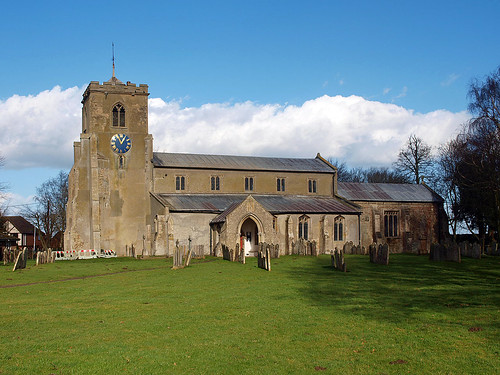ST JAMES. The oldest part is the circular piers of the arcade. Their bases seem to be Norman. The rest of the arcade, including the capitals, however, is C14. So are most of the other parts of interest, the lower part of the tower (with angle buttresses) and the tower arch, the big W window displaying flowing tracery, the aisle windows and the handsome S porch. The chancel with the chancel arch and the upper parts of the tower followed Perp. Inside, the rood stairs are arranged in a picturesque way. The access from the upper door to the loft itself was by a short embattled passage. - FONT. Big, octagonal, Perp, with a traceried stem and a bowl with large elaborate quatrefoils carrying shields. - PLATE. Cup, Paten, Flagon, all gilt, all of 1663; Almsdish of 1662.
NEWTON-IN-THE-ISLE. It lies near Wisbech and looks over the wide flats of the fens, but its stone church is apart among fine trees. We come into it through two medieval doorways, one with a king and queen on each side, and the other in a porch with an unusual Nativity scene in a window; it shows a woman and two noblemen with sword and dagger, bringing their gifts, while two angels hold a curtain behind. Like most of the church, the tower and spire are 14th and 15th century, but the round pillars bearing the nave arcades may be Norman. The clerestory is 15th century, and so is the chancel arch, in which is a richly carved modern screen with a vaulted canopy supporting a roodloft gallery with traceried bays. It is reached by the old rood stairs. In the sanctuary floor is an ancient coffin stone carved with three crosses.

No comments:
Post a Comment